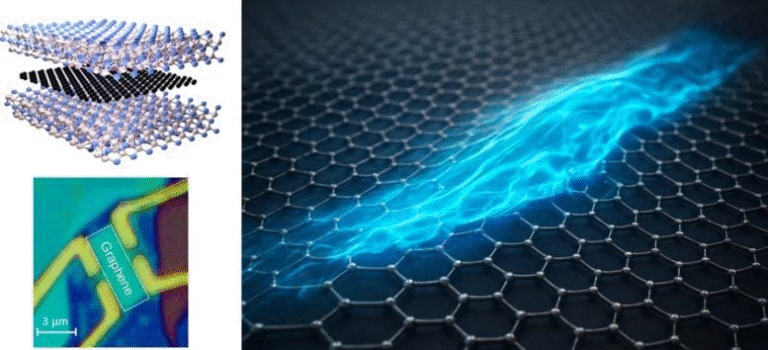Scientists Intentionally Add Defects to Graphene — Turning Imperfections Into Superpowers

Graphene has been hailed as one of the most remarkable materials ever discovered — a single layer of carbon atoms arranged in a perfect honeycomb lattice. It’s lighter than paper, stronger than steel, and an excellent conductor of electricity and heat. For years, scientists have chased ways to harness its properties for real-world devices like sensors, semiconductors, and batteries.
But there’s a catch: graphene’s perfection is also its weakness. In its flawless form, graphene doesn’t easily bond with other materials and lacks certain electrical behaviors needed for next-generation electronics.
Now, a team of researchers from the University of Nottingham, University of Warwick, and Diamond Light Source has flipped the script. Instead of avoiding defects, they’ve deliberately introduced them — and the results are opening up new possibilities for how graphene can be used.
Their study, published in Chemical Science, demonstrates a new one-step process to grow graphene that naturally incorporates carefully designed imperfections. The outcome? Graphene that’s not just strong and conductive, but also tunable, reactive, and far more versatile.
A New Way to Make Graphene: Building Imperfections on Purpose
Traditionally, scientists have treated defects in materials as a problem — something to minimize or remove. But this research takes a bold new direction. The team created graphene that includes specific, topological defects — regions where the usual six-membered carbon rings are replaced by five- and seven-membered rings.
These aren’t random flaws. They’re engineered structural features that can dramatically change how graphene behaves. Defects like these can modify the material’s electronic, magnetic, and chemical properties, making it more interactive and adaptable for various technologies.
To achieve this, the researchers used a molecule called Azupyrene as the carbon source. What’s special about Azupyrene is its geometry — it already contains the irregular ring structure the scientists wanted to introduce into the graphene lattice.
When used as a precursor in the growth process, Azupyrene “transfers” its unusual structure into the resulting graphene film, giving it a built-in network of controlled imperfections.
One-Step Synthesis with Controlled Defects
The process itself is surprisingly efficient. The team developed a one-step chemical vapor deposition (CVD) method that grows graphene-like films directly on a surface. This means they can produce large, continuous sheets of defective graphene without needing complex post-processing or damage-inducing treatments.
A crucial part of their discovery is defect control. By simply adjusting the temperature during the growth process, they can determine how many defects appear in the final graphene film.
- At higher temperatures, the graphene becomes more “perfect,” with fewer defects.
- At lower temperatures, more imperfections appear, enhancing the material’s chemical reactivity and functional properties.
This tunability is what makes the breakthrough so exciting. Scientists can now design graphene for specific applications, choosing exactly how much imperfection they want.
Keeping Defects Intact During Transfer
One of the biggest challenges in graphene research has been transferring the material from its growth substrate to another surface without damaging it. This is critical if you want to integrate graphene into real-world devices like sensors or transistors.
In this study, scientists at the Graphene Institute in Manchester successfully moved the defective graphene films onto various surfaces while preserving the defects. That means the special atomic structures stayed intact, maintaining the enhanced properties that the researchers worked so hard to create.
This successful transfer step marks a major milestone. It proves that the method isn’t just a lab curiosity — it’s a practical route toward functional graphene-based devices.
A Deep Dive with Cutting-Edge Tools
To verify their results, the research team used an impressive suite of analytical techniques to study the atomic structure and behavior of the defective graphene.
They combined:
- Advanced microscopy (scanning tunneling microscopy and non-contact atomic force microscopy)
- Spectroscopy techniques (X-ray photoelectron spectroscopy and near-edge X-ray absorption fine structure)
- Synchrotron radiation from major research facilities such as Diamond Light Source in the UK and MAX IV in Sweden
- High-performance simulations on the UK’s ARCHER2 supercomputer
This multi-institutional effort allowed them to see how defects formed and how they affected the graphene’s electronic and chemical properties at the atomic scale.
By comparing experimental data with density functional theory (DFT) simulations, they could confirm that the irregular ring structures were present and stable — not random or accidental.
Why Defects Matter in Graphene
Perfect graphene may sound ideal, but in reality, it’s sometimes too perfect. Because its atoms are arranged in a flawless hexagonal pattern, it interacts only weakly with other materials. That’s bad news if you want graphene to act as a sensor, catalyst, or semiconductor component.
Defects change everything.
When a five- or seven-membered ring disrupts the hexagonal network, it changes how electrons move through the lattice and how molecules attach to its surface. This can:
- Increase chemical reactivity, making graphene more “sticky” for attaching catalysts or functional molecules
- Create localized electronic states, which can be tuned for semiconducting behavior
- Induce magnetic properties in regions where there were none before
- Enhance gas detection by improving how gases adsorb onto the surface
These effects are exactly what industries need to make graphene more than just a scientific curiosity. Defective graphene could enable sensitive chemical sensors, flexible semiconductors, or catalytic materials for clean energy technologies.
From Flaws to Functionality
The idea of turning “flaws” into useful features isn’t new, but applying it so precisely in graphene is groundbreaking. Normally, introducing defects requires post-growth treatments like ion bombardment or oxidation — techniques that are hard to control and often damage the surrounding lattice.
In contrast, this new approach builds the defects in from the start, with control and predictability. It’s like designing the wrinkles instead of causing random cracks.
The researchers describe this as “molecular design meets material engineering” — by choosing the right precursor molecule (Azupyrene) and the right conditions, they can sculpt the graphene structure at the molecular level.
International Collaboration and Shared Expertise
This wasn’t the work of one lab. It’s the product of a large collaboration spanning multiple universities and national research facilities across the UK, Germany, and Sweden.
The University of Nottingham led the molecular synthesis and growth method. The University of Warwick contributed detailed computational modeling to understand the defect formation mechanisms. The Diamond Light Source and MAX IV synchrotrons provided the high-energy X-rays used to map the graphene’s atomic structure.
Such cross-disciplinary work — combining chemistry, physics, and computational modeling — is exactly what’s needed to solve challenges at the frontier of materials science.
What’s Next for Defective Graphene
While the study demonstrates a major step forward, there are still hurdles to overcome before this technology makes its way into commercial products. Researchers will need to:
- Scale up production while maintaining uniform defect distribution
- Balance defect density to optimize performance without sacrificing conductivity or mechanical strength
- Ensure stability of the defected graphene under real-world operating conditions
- Integrate the films into working devices like transistors, batteries, or sensors
Still, this research changes the way scientists think about graphene. Instead of chasing impossible perfection, the focus is shifting toward precision imperfection — creating materials that are purposefully designed to perform better because of their engineered flaws.
A Quick Refresher: What Exactly Is Graphene?
Before we wrap up, it’s worth revisiting what makes graphene so special.
Graphene is a two-dimensional sheet of carbon atoms arranged in a honeycomb lattice. It was first isolated in 2004 by scientists at the University of Manchester, who won the Nobel Prize in Physics for their discovery.
Some of its standout properties include:
- Unmatched strength – around 200 times stronger than steel.
- High electrical and thermal conductivity – better than copper.
- Flexibility and transparency – it can bend without breaking and conduct electricity while remaining nearly invisible.
These characteristics make it ideal for a wide range of applications: from flexible electronics and touchscreens to energy storage, medical devices, and advanced composites.
However, real-world use has been limited because pure graphene doesn’t always behave as needed — especially when it comes to bonding with other materials or exhibiting semiconducting behavior.
That’s where the concept of defect engineering comes in. By carefully introducing imperfections, scientists can tune the properties of graphene, turning it into a more adaptable and functional material.
Why This Study Stands Out
What makes this new research remarkable is the level of control achieved. Scientists have long known that defects could be useful, but they couldn’t control where or how they formed. This study shows that with the right molecular precursor and growth method, defects can be designed and built in from the beginning, not added after the fact.
It’s a shift from repairing broken graphene to designing better graphene.
And by understanding exactly how those imperfections change the material’s properties, researchers can start to predict and customize graphene’s behavior — something that was nearly impossible before.





